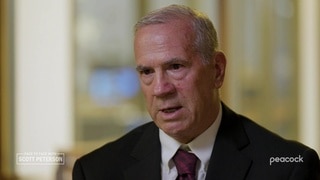Create a free profile to get unlimited access to exclusive videos, breaking news, sweepstakes, and more!
How Was Laci Peterson Actually Killed? Why Investigators Reference the "Soft Kill" Theory
“Even a soft kill leaves behind some sort of trail,” a crime journalist told Face to Face with Scot Peterson.
In 2004, Scott Peterson was convicted of killing his wife, Laci Peterson, and their unborn son, Conner. But two decades later, how Laci died remains a mystery.
A key theory in the infamous case is that it was a "soft kill," a legal analyst notes in Peacock's new three-part docuseries Face to Face with Scott Peterson, now streaming. But what does that mean? Here's what is known about how Laci died, and what investigators believe happen.
What is a "soft kill"?
In a homicide investigation, a "soft kill" refers to a method of murder that leaves minimal visible trauma or immediate evidence, like suffocation or other means that don’t cause overt injuries.
“A soft kill is a murder that doesn’t involve a weapon and doesn’t leave behind essentially obvious forensic evidence,” legal analyst Chris Pixley told Face to Face with Scott Peterson.
How was Laci Peterson killed?
On Christmas Eve 2002, Laci, 27, who was eight months pregnant, vanished from her home in Modesto, California. In April 2003, Laci’s remains and those of her unborn son washed up separately in the San Francisco bay. Examiners could not determine the manner of death because of the level of decomposition.
Investigators were also unable to determine how or where she had been killed as well thanks to a lack of hard evidence, like bloodstains or DNA.
In this case, the notion of a soft kill offered the possibility that Laci was murdered in a way that left no trace before she was put in the water.
Prosecutors “have this theory of the soft kill,” Scott’s defense attorney Mark Geragos told the court in November 2004.
“The reason for this,” he continued in the court transcript, “is because they’ve got no evidence … if there’s no blood, there’s no poisoning, there’s no knife with blood on it, there’s no gun, there’s no nothing that shows how she was killed — then you’ve got to come up with this theory of a soft kill.”
Geragos argued that there was no hard evidence that the cause of death was a soft kill.
“You don’t commit a violent crime without getting your hands dirty,” said Pixley, adding that police executed more than 10 search warrants on the Peterson home and the defendant’s place of business.
“They didn’t know how he did it, when he did it,” Ted Rowlands, Court TV anchor, told the documentary. “But they knew that he was a liar, a cheater, and they relied on that ... After they found pretty much zero physical evidence in the house or in the truck or in the boat, the theory had to become that this was a soft skill."
The prosecution, however, argued it had plenty of circumstantial evidence, including his affair, his whereabouts on the day Laci went missing, and how he acted before and after the case began, and more, to prove Scott was the culprit behind Laci's death. Scott Peterson was convicted of murdering Laci and Conner in 2004. He is currently carrying out a life sentence in prison.
The three-part docuseries Face to Face with Scott Peterson is streaming on Peacock. The series will also air on Oxygen on Monday, November 25 at 8/7c.































